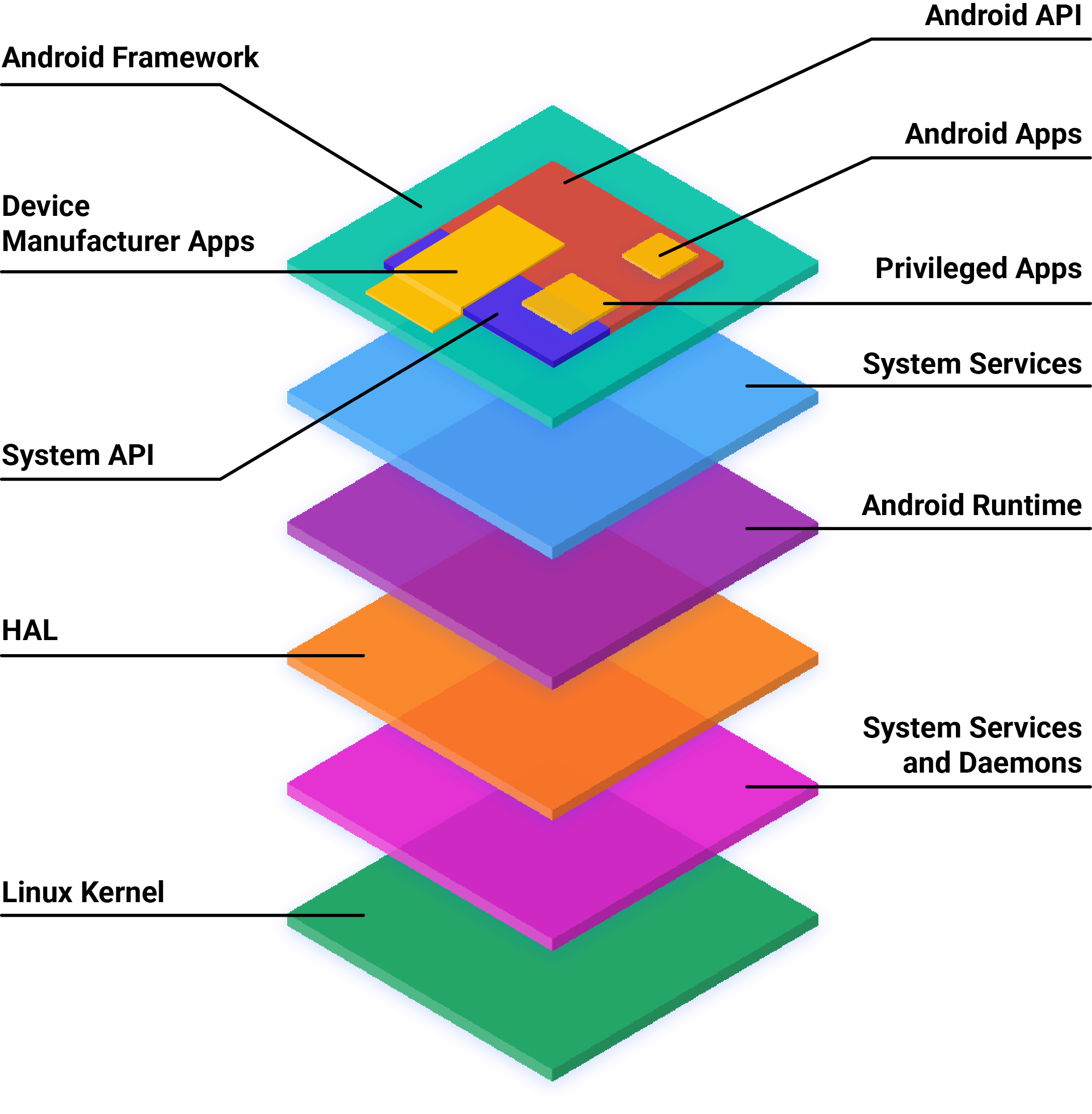پروژه منبع باز Android (AOSP) کد منبع اندرویدی در دسترس عموم و قابل تغییر است. هر کسی می تواند AOSP را برای دستگاه خود بارگیری و تغییر دهد. AOSP یک پیاده سازی کامل و کاملا کاربردی از پلتفرم موبایل اندروید را ارائه می دهد.
دو سطح سازگاری برای دستگاههای پیادهسازی AOSP وجود دارد: سازگاری AOSP و سازگاری Android. یک دستگاه سازگار با AOSP باید با فهرست الزامات موجود در سند تعریف سازگاری (CDD) مطابقت داشته باشد. یک دستگاه سازگار با Android باید با فهرست الزامات موجود در CDD و الزامات نرمافزار فروشنده (VSR) و آزمایشهایی مانند موارد موجود در مجموعه تست فروشنده (VTS) و مجموعه تست سازگاری (CTS) مطابقت داشته باشد. برای اطلاعات بیشتر در مورد سازگاری Android، به برنامه سازگاری Android مراجعه کنید.
معماری AOSP
پشته نرم افزار برای AOSP شامل لایه های زیر است:

شکل 1. معماری پشته نرم افزار AOSP.
در زیر لیستی از تعاریف برای اصطلاحات استفاده شده در شکل 1 آمده است:
- برنامه اندروید
- برنامه ای که صرفاً با استفاده از API Android ایجاد شده است. Google Play Store به طور گسترده ای برای یافتن و دانلود برنامه های اندروید استفاده می شود، اگرچه گزینه های بسیار دیگری نیز وجود دارد. در برخی موارد، سازنده دستگاه ممکن است بخواهد یک برنامه Android را برای پشتیبانی از عملکرد اصلی دستگاه از قبل نصب کند. اگر به توسعه برنامههای Android علاقه دارید، به developers.android.com مراجعه کنید.
- برنامه ممتاز
- برنامه ای که با استفاده از ترکیبی از Android و APIهای سیستم ایجاد شده است. این برنامهها باید بهعنوان برنامههای ممتاز روی یک دستگاه از قبل نصب شده باشند.
- برنامه سازنده دستگاه
- برنامه ای که با استفاده از ترکیبی از API Android، API سیستم و دسترسی مستقیم به پیاده سازی فریمورک اندروید ایجاد شده است. از آنجا که سازنده دستگاه ممکن است مستقیماً به APIهای ناپایدار در چارچوب Android دسترسی داشته باشد، این برنامهها باید از قبل روی دستگاه نصب شده باشند و فقط زمانی میتوانند بهروزرسانی شوند که نرمافزار سیستم دستگاه بهروزرسانی شود.
- سیستم API
- System API نشاندهنده APIهای Android است که فقط برای شرکا و OEMها برای گنجاندن در برنامههای همراه در دسترس هستند. این APIها به عنوان @SystemApi در کد منبع مشخص شده اند.
- Android API
- Android API API در دسترس عموم برای توسعه دهندگان برنامه اندروید شخص ثالث است. برای اطلاعات در مورد Android API، به مرجع Android API مراجعه کنید.
- فریمورک اندروید
- گروهی از کلاسهای جاوا، رابطها و سایر کدهای از پیش کامپایلشده که برنامهها بر اساس آنها ساخته میشوند. بخشهایی از چارچوب از طریق استفاده از API Android به صورت عمومی در دسترس هستند. بخشهای دیگر چارچوب فقط برای OEMها از طریق استفاده از APIهای سیستم در دسترس است. کد فریم ورک اندروید در فرآیند یک برنامه اجرا می شود.
- خدمات سیستمی
- سرویسهای سیستم اجزای ماژولار و متمرکزی مانند
system_server، SurfaceFlinger و MediaService هستند. عملکردی که توسط API چارچوب Android در معرض دید قرار میگیرد، با سرویسهای سیستم برای دسترسی به سختافزار زیربنایی ارتباط برقرار میکند. - زمان اجرا اندروید (ART)
- یک محیط زمان اجرا جاوا ارائه شده توسط AOSP. ART ترجمه بایت کد برنامه را به دستورالعمل های مخصوص پردازنده انجام می دهد که توسط محیط زمان اجرا دستگاه اجرا می شوند.
- لایه انتزاعی سخت افزاری (HAL)
- HAL یک لایه انتزاعی با یک رابط استاندارد برای پیاده سازی فروشندگان سخت افزار است. HALها به اندروید اجازه میدهند که نسبت به پیادهسازی درایورهای سطح پایینتر بیاعتنا باشد. استفاده از HAL به شما این امکان را می دهد که عملکردها را بدون تأثیرگذاری یا اصلاح سیستم سطح بالاتر پیاده سازی کنید. برای اطلاعات بیشتر، به نمای کلی HAL مراجعه کنید.
- شیاطین و کتابخانه های بومی
دیمون های بومی در این لایه عبارتند از
init,healthd,logdوstoraged. این دیمونها مستقیماً با هسته یا سایر رابطها تعامل دارند و به پیادهسازی HAL مبتنی بر فضای کاربر وابسته نیستند.کتابخانه های بومی در این لایه شامل
libc،liblog،libutils،libbinderوlibselinuxهستند. این کتابخانههای بومی مستقیماً با هسته یا سایر رابطها تعامل دارند و به پیادهسازی HAL مبتنی بر فضای کاربر وابسته نیستند.- هسته
هسته بخش مرکزی هر سیستم عامل است و با سخت افزار زیرین دستگاه صحبت می کند. در صورت امکان، هسته AOSP به ماژول های سخت افزاری و ماژول های خاص فروشنده تقسیم می شود. برای توضیحات، از جمله تعاریف، اجزای هسته AOSP، به نمای کلی کرنل مراجعه کنید.
بعدش چی؟
- اگر با AOSP تازه کار هستید و می خواهید توسعه را شروع کنید، به بخش شروع کنید مراجعه کنید.
- اگر میخواهید درباره لایه خاصی از AOSP اطلاعات بیشتری کسب کنید، روی نام بخش در ناوبری سمت چپ کلیک کنید و با نمای کلی آن بخش شروع کنید.

